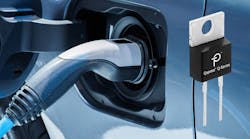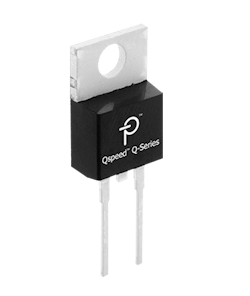What you'll learn:
- What are the parameters of a diode's reverse-recovery behavior?
- The impact of the softness of a diode’s IRR waveform.
- Benefits of the Q-series diodes.
Power Integrations’ 600-V, 12-A “Qspeed” diode delivers what the company says is the industry’s lowest reverse-recovery charge (QRR) for a silicon diode. With a QRR of just 14 nC at 25°C, it improves the efficiency of the power-factor-correction (PFC) stage of on-board chargers and reduces the thermals of the PFC MOSFETs.
Generally speaking, silicon-carbide (SiC) technology provides superior switching performance and higher reliability compared to silicon devices. SiC diodes have no reverse-recovery current and switching performance is independent of temperature. Thermal performance, increased power density, and reduced EMI have made SiC a compelling choice for a growing number of high-performance automotive applications.
According to Power Integrations, though, the AEC-Q101-qualified QH12TZ600Q offers the same low-switching loss performance of a SiC device without the disadvantages of moving to more expensive technology.
A diode’s reverse-recovery behavior is quantified by three parameters: the reverse-recovery time (tRR), the reverse-recovery current (IRR), and the reverse-recovery charge (QRR). IRR, tRR, and QRR are typically specified on datasheets. The QRR of PN-junction power diodes has been shown to be a more accurate performance metric than its tRR, since devices with low tRR don’t necessarily have low QRR and IRR.
Another parameter that’s not always specified on the datasheet is the softness of the diode’s IRR waveform. That softness determines if snubber circuits will be required to use it safely and to meet conducted and radiated EMI test limits.
IRR softness is the ratio of the two parts of the reverse-recovery current: stored charge removal and the return-to-zero current. Softness is calculated by dividing the time required to remove the stored charge carriers from the diode (ta) into the time it takes for the resultant reverse current to fall from its peak negative value (IRR_PEAK) back to zero (tb).
These four parameters are determined by the manufacturing processes used to produce a particular device family. The Q-Series family of parts was designed so that the QRR of all devices have a low, positive temperature coefficient. That means the QRR, IRR, and tRR of those diodes will not increase significantly over the normal operating junction temperature range.
The fact that the QRR and IRR of the Q-Series devices remain consistently low, over a normal operating temperature range, can help to ensure that power-supply efficiency and EMI remain within specification—even at the worst-case operating conditions
According to Edward Ong, senior product marketing manager at Power Integrations, the QRR of the new Qspeed diodes “is half that of the next best ultra-fast silicon diodes, resulting in very high system efficiency. This is particularly important for automotive on-board charger applications that require higher switching frequency to reduce volume and weight, and enables the Qspeed diodes to replace SiC devices.”
The QH12TZ600Q uses merged PIN and Schottky diode technology. According to the supplier, smooth reverse-recovery current transition characteristics not only increase efficiency, but also reduce EMI and peak reverse-voltage stress, eliminating the need for snubbers when used as output rectifiers in on-board chargers. Devices are available in a compact, 2.5-kV isolated TO-220 package, which enables direct mounting to metal heat sinking, facilitating improved thermal performance.

